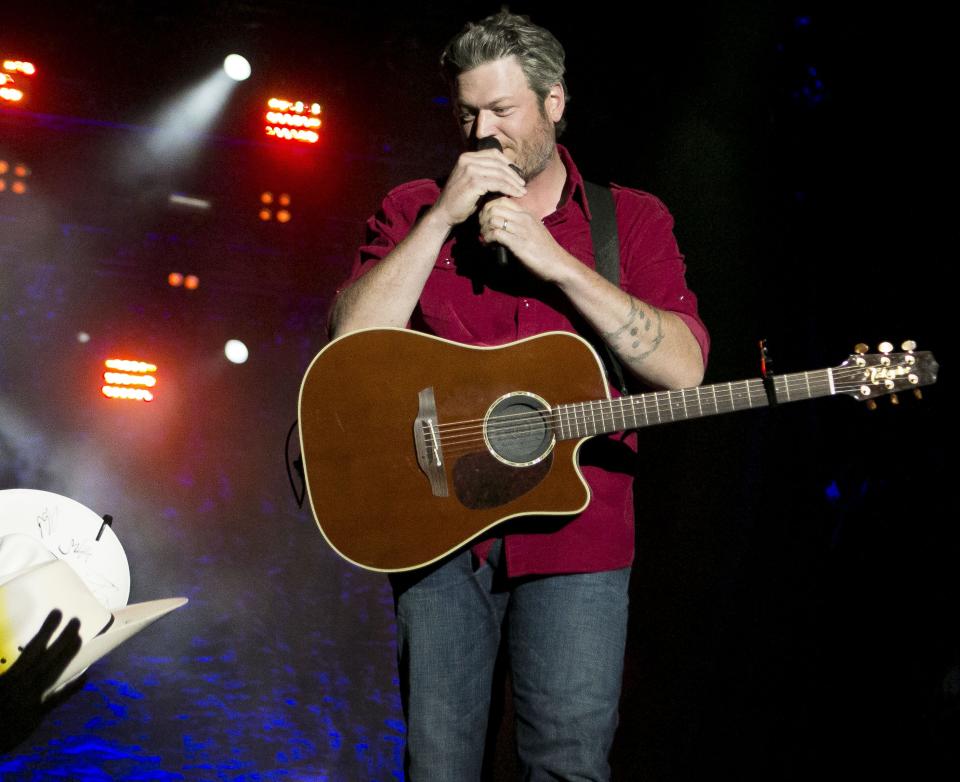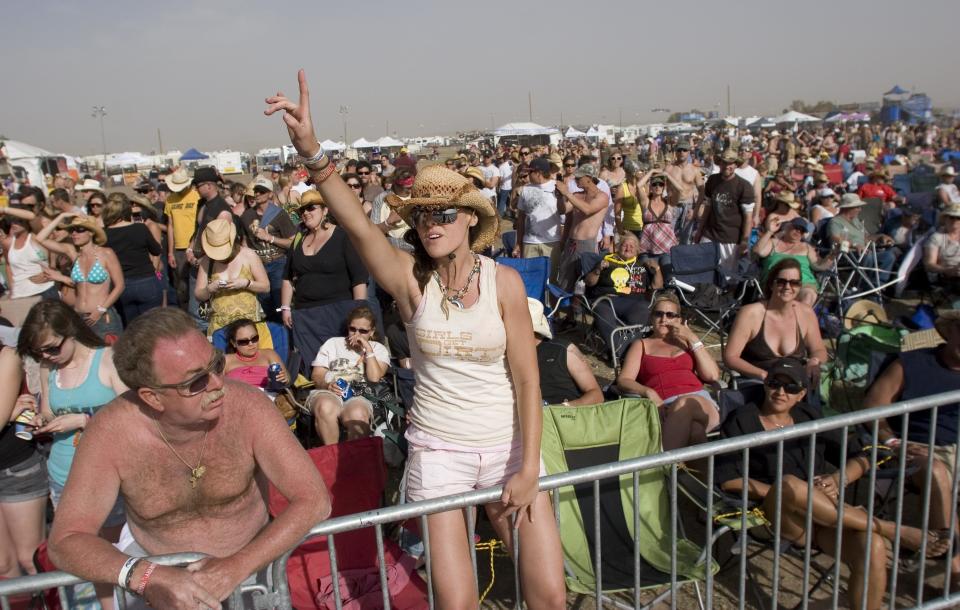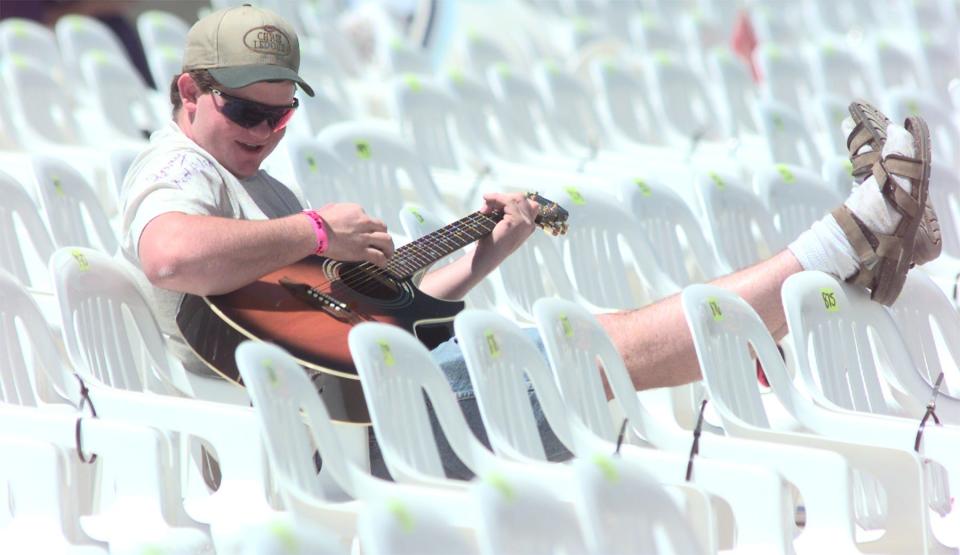Flashback to Country Thunder Arizona's '90s origin story and the stars that made it shine
It’s been 30 years since Country Jam USA welcomed music fans to Queen Creek Mayor Mark Schnepf’s family farm for a four-day festival that would evolve into the massive annual cultural phenomenon now known as Country Thunder Arizona.
The company behind Country Jam USA had launched the concept four years earlier in Eau Claire, Wisconsin, holding similar events in Lake Geneva, Wisconsin, and Grand Junction, Colorado, before rolling into Queen Creek, Arizona, for a festival that launched on April 7, 1994.
That first year in Arizona featured Kenny Rogers, Tanya Tucker, John Michael Montgomery, Sawyer Brown, Diamond Rio, Chris LeDoux, Mark Chesnutt, Billy Dean, Collin Raye, Nitty Gritty Dirt Band, Faith Hill, Kathy Mattea and more taking the stage (800 tons of concrete poured specifically for the occasion).
Here are the ups and downs of Country Thunder Arizona's origin story.
Check azcentral.com or follow us on Instagram and TikTok all weekend for live updates, concert reviews and setlists from Country Thunder 2024, which runs April 11-14 at Canyon Moon Ranch in Florence, AZ.
Our complete Country Thunder Arizona 2024 coverage includes the concert lineups and set times, how to minimize the traffic hassles and a live blog updated hourly all weekend.
Country Jam USA was billed as the Super Bowl of Country Music
In an Arizona Republic article on Sept. 1, 1993, seven months before a festival billed as the Super Bowl of Country Music, a local resident named Joan Rose said many people in her neighborhood did not wish to see a country music festival.
Not in their backyard.
“It will attract a lot of dope, alcohol and vandalism,” she said. “I attended a country thing out at Estrella Park a while back and that was a disaster. Things happened under those trees I wouldn’t want my kids to see.”
Festival director Marshall Harris assured The Republic that while Country Jam crowds were large, they weren’t enormous or rowdy. He said about 30 percent of the crowd would be younger than 25, 40 percent between 25 and 55, and another 30 percent older than 55.
Harris said that when considering locations, he asked Arizonans he met if they even knew where Queen Creek was and they would invariably tell him no.
“Next year, they will,” he promised.
Country Thunder traffic got you down? Here's how to minimize the aggravation
Country Jam USA 'far surpassed' the country Woodstock hype
Tickets to the inaugural Country Jam USA were $35 a day and $75 for a weekend pass. Campsites were $75 for the weekend.
Ron Meredith, a plumber from Tucson, brought his wife and kids to what he figured to be a historic event.
As he told The Republic reporter asking questions at the campground, “I think it’ll be one of the neatest things that ever happened to Arizona.”
Music writer Larry Rodgers reviewed the inaugural festival for The Republic.
“Country Jam USA didn’t exactly live up to its billing as ‘the Woodstock of country music’ – it far surpassed it,” his review began.
“A first-class production that pampered music fans and performers alike awaited the thousands who made the pleasant journey out of the Valley to the farmland of Queen Creek. … State-of-the-art sound and a giant video screen left even those in the back 40 plugged into the parade of big-name C&W acts.”
The 1st Country Jam USA lost money, owed rent to Schnepf Farms
About 10,000 fans attended the first Country Jam USA, far fewer than anticipated. Projections were calling for 15,000 to 20,000.
When the festival’s promoter, Larry Barr, announced in January 1995 that he was coming back to Queen Creek in the spring with a festival he’d renamed Country Thunder USA after splitting with his business partners, The Republic ran an article that stated Barr had only paid 60 percent of the rent he’d promised Schnepf Farms for Country Jam USA.

Despite that, the Schnepfs agreed to allow a second festival to proceed while waiting on the back rent, which Barr told The Republic he expected to have paid off by September 1995, rather than force the event into bankruptcy.
In that article, Barr said, “We had a rough first year and lost a lot of money, but we aren’t running away. We are paying our debts and are hoping for a more successful event this year.”
Barr added, “We said this was a three-year project. It takes three years to get the growing pains out of the way.”
Country Jam USA rebrands to Country Thunder USA
The festival scaled back from four days to three with ticket prices dropping to $30 a day or $60 for a weekend pass in the hope of drawing bigger crowds. A second campground 600 feet from the entrance was added for $30 for the weekend.
The first Country Thunder USA featured Ricky Van Shelton, Sawyer Brown, Confederate Railroad, Lorrie Morgan, Tracy Lawrence, Collin Raye, Martina McBride, John Michael Montgomery, Dan Seals, Tim McGraw and Jeff Foxworthy.
Country Thunder USA returned to Queen Creek again in 1996 with Tim McGraw, Faith Hill, Billy Ray Cyrus, Nitty Gritty Dirt Band, Blackhawk, Martina McBride, Charlie Daniels, Asleep at the Wheel, Emilio, Lonestar, Mark Chesnutt, Ty Herndon and more.
Admission was $75 for a three-day pass or $35 a day, with VIP seating going for $400 and reserved seats for $200.
In a preview of the festival, The Republic called it “Arizona’s ‘Woodstock of the West.’”
Two days after Country Thunder Arizona closed, The Republic wrote that “while the turnstile returns aren’t in yet, attendance records may well have been shattered – this despite (or thanks to?) triple-digit temperatures.”
Tim McGraw and Faith Hill lit up Country Thunder 1996
The Republic review by Larry Crowley singled out John Berry, Mark Chesnutt and an energetic performance by Tejano star Emilio that included “a rolling rendition of his famed ‘Emilio Shuffle,’” as highlights.
Crowley also wrote that Sunday “proved to be the perfect capper to the weekend.”
After noting performances by Jo Dee Messina, Ty England, Asleep at the Wheel and “grizzled veteran” Charlie Daniels, Crowley wrote that “Faith Hill simply stole the night.”

Hill’s set featured “first-class renderings” of her first three country chart-toppers — “Wild One,” “It Matters to Me” and her version of “Piece of My Heart,” an Erma Franklin R&B classic famously covered by Big Brother and the Holding Company with a young Janis Joplin on vocals.
Hill was followed by the singer she married six months later, Tim McGraw, who “brought all to their feet with his usual high-energy offerings, including “I Like It, I Love It.”
Crowley ended his review with “Judging from the healthy line at the 1997 renewal booth (and long lines everywhere else including unfortunately at the portable restrooms), County Thunder USA should be around for a spell.”
The 1996 edition drew 70,000 fans.
By 1997, word of mouth had established Country Thunder as a hit
In 1997, The Republic reported that more than 100,000 people were expected at Country Thunder USA, which added a fourth day.
Among the high-profile acts were Toby Keith, Billy Dean, John Michael Montgomery, Sawyer Brown, Blackhawk, LeAnn Rimes, Chris LeDoux, Joe Diffie, Jeff Foxworthy, Ricochet and Tim McGraw making his third Country Thunder appearance in as many years.
As Ali Powell, a Country Thunder publicist, told The Republic, “The event is growing pretty quickly, mostly due to word of mouth.”
A four-day pass was $80 at the gate; $70 in advance. Single-day tickets were $20 for Thursday. Single-day tickets for Friday, Saturday and Sunday were $40 at the gate; $35 in advance.
The Tucson Citizen’s A.J. Flick began her review with an extended weather metaphor.
“A strong system moved into central Arizona from Tennessee last weekend," Flick wrote, "leaving in its wake lots of sun, fun and thousands of happy music lovers.
750 Country Thunder fans suffered breathing problems in 1997
The 1997 festival, which drew 115,000 fans, did not go off without a hitch.
Three days after McGraw brought the festival to a close, The Republic reported that 750 festivalgoers sought treatment for breathing problems, with 60 people taken to the hospital on Saturday.
A fire department spokesman told The Republic the ailments were likely caused by fans breathing a mixture of alfalfa and dust that had been kicked up by the concertgoers.
“We’ve had severe dust storms in the Valley before when visibility was just a half-mile and never saw these kinds of numbers seeking help,” Colin Williams told The Republic. “So our guess is the alfalfa had something to do with it.”
Country Thunder 1998: 6 stages, 120,000 fans and a rodeo arena
Country Thunder USA returned to Schnepf Farms in 1998 with Clay Walker, Alabama, Clint Black and Blackhawk headlining a bill that also featured LeAnn Rimes, Lonestar, Chris LeDoux, the Kinleys, Michael Peterson, Blackhawk, Trace Adkins, Neal McCoy, Ty Herndon and more.
Tickets were $25 a day or $60 for a four-day pass.
Attendance topped 120,000 for the weekend.

The 1998 edition had six stages, seven campgrounds, a rodeo arena that featured opportunities for amateurs to try their luck and 200 arts and crafts booth on 244 acres of farmland.
One of those stages, new that year, was the Fiesta Alegre Saloon, which featured Tex-Mex, Tejano and Latino acts, including Ballet Folklorico and Shelly Lares.
A Country Thunder rep told The Republic “It’s a spice of the Southwest. It wasn’t planned. It’s just happened.”
The Tucson Citizen credited the festival with converting a “sleepy farm community” to Nashville West.
Reba, Brooks & Dunn close out Country Thunder in the '90s
Country Thunder finished the ‘90s at Schnepf Farms with performances by Reba McEntire, Brooks & Dunn, John Michael Montgomery, Collin Raye, Faith Hill, Neal McCoy, Toby Keith, Montgomery Gentry, Ricochet, Tracy Byrd, Deana Carter, BR549 and more.
The festival once again featured a rodeo and 200 arts and crafts vendors.
A week before the 1999 festival, the Arizona Daily Star wrote, “Even Nashville envies Larry Barr these days. The owner and manager of Country Thunder USA has in six short years become one of the top concert-festival organizers in country music, with his four day Queen Creek festival landing in the top six country music events of the year in 1997.
Attendance topped 150,000 for the first time in 1999.
A Country Thunder USA rep told the Daily Star the festival’s success might have a lot to do with timing, bringing major country stars to Arizona in the leadup to the annual Academy of Country Music Awards in Los Angeles.
Barr said he felt keeping ticket prices down helped Country Thunder pull in bigger crowds. In 1999, tickets were $35 a day or $70 for a four-day pass.
“You’re getting a lot of entertainment for not a lot of dollars,” he said. “You’re paying the same amount for one concert, for two hours, for the amount we give you for 12 hours.”
Reba, Brooks & Dunn close out the '90s at Country Thunder
Cathalena E. Burch reviewed Montgomery Gentry’s headlining set on the opening day for the Daily Star.
“Eddie Montgomery and Troy Gentry achieved an amazing feat at last night’s opening of Country Thunder ’99,” she wrote. “They cleared the lines at the food and beer tents in the time it took Troy Gentry to strike a note on his guitar.”
Nasty weather caused a break in Friday’s action, delaying evening sets by Deana Carter, Toby Keith and John Michael Montgomery by an hour.
“For those patient and warm enough to stick it out, the delay was worth it just to see Carter sing her anthem ‘Did I Shave My Legs for This,’” Burch wrote.
Burch also covered Saturday’s performers.
“Last night’s powerful lineup covered the gamut of country music, from (Tracy) Byrd’s honky-tonky, throw-back style reminiscent of George Jones and Merle Haggard, to the fresh-faced (David) Kersh spicing things up with a little Metallica and AC/DC,” she wrote.
“But leave it to McCoy to turn a country hoe-down into a rip-roaring, rock ‘n’ rap tinged party that at times sounded more like a Beastie Boys and Commodores revival than a Texas-born country show.”
She saved her highest praise for Brooks & Dunn.
“There was no contest who ruled the night,” Burch wrote. “From the second they emerged from backstage, Kix Brooks and Ronnie Dunn were enveloped in thunderous applause and screaming. A simple wave of the hand evoked even more shouts, whistles and clapping – almost loud enough to drown out Dunn singing lead on their classic dance tunes.”
More than 100 festivalgoers were treated for breathing problems Saturday due to airborne dust, with 20 people taken to the hospital.
Burch was back on Sunday for the final day.
“Country Thunder ’99 wrapped up with ladies’ night and a few surprises yesterday as two of country music’s top female acts captivated a 40,000-strong crowd,” she wrote.
“But if anyone thought Faith Hill and Reba McEntire would end the four-day romp on a quiet note, they were likely disappointed. Faith and Reba may be of the so-called softer sex, but someone forgot to include that in their country music book of etiquette.”
After praising Hill’s performance, Burch wrote, “You would think after 23 years in the business, McEntire would have slowed down by now. But her energy soared from the moment she ran on stage and sang “Tell Me Why.’ And she kept up the pace throughout her 75-minute set.”
McEntire’s set included a tip of the hat to Tucson legend Linda Ronstadt, garnering some of the loudest applause of the night for singing “You’re No Good.”
Burch ended her review with “The organizers of Country Thunder will have a hard time topping this year’s festival.”
How Country Thunder came to Florence, AZ
Twenty-five years later, Country Thunder Arizona is still going strong. The final festival at Schnepf Farms took place in 2002, a year after Barr sought federal bankruptcy protection.
Country Thunder moved into its current home at Canyon Moon Ranch near Florence, Arizona, in 2003.
It returns to Florence on Thursday, April 11, for four more days of country music in the desert.
Festival organizers are anticipating an average of 25,000 festivalgoers a day for headlining performances by Lainey Wilson, Eric Church, Jelly Roll and Koe Wetzel.
'To hell with everybody': How Koe Wetzel forged his own way to the top in country music
Reach the reporter at [email protected] or 602-444-4495. Follow him on Twitter @EdMasley.
Support local journalism. Subscribe to azcentral.com today.
This article originally appeared on Arizona Republic: Country Thunder Arizona in the '90s: From shaky start to huge hit
